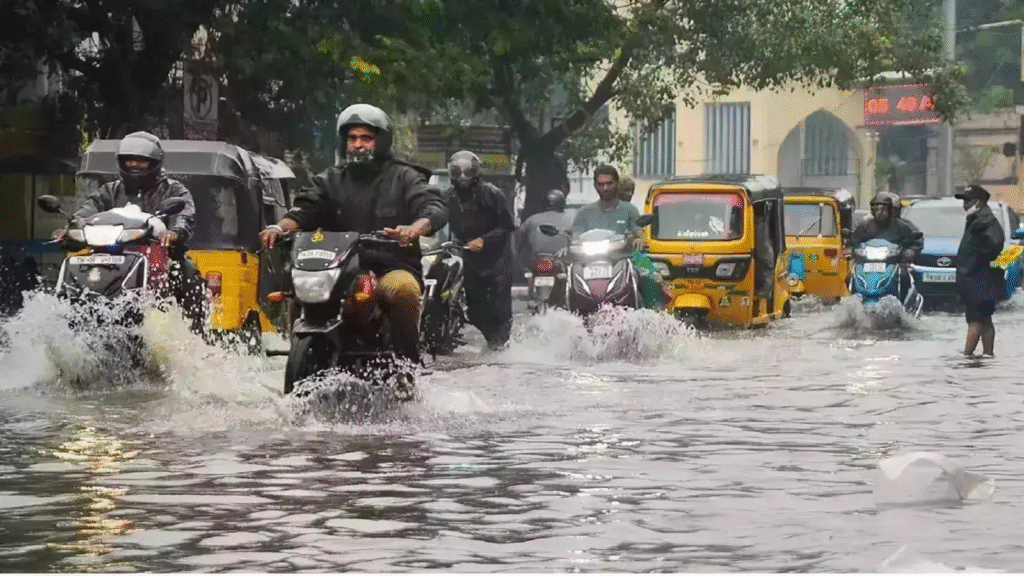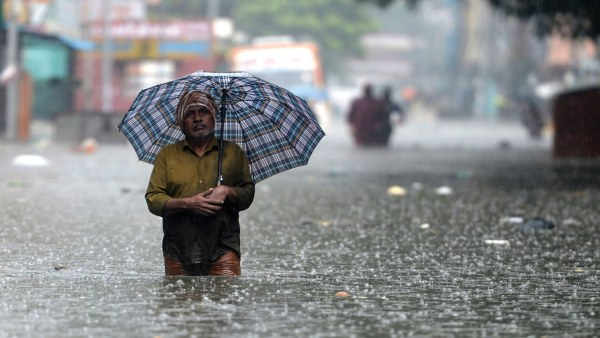
Bengaluru, a city renowned for its pleasant weather and vibrant lifestyle, is currently battling an extended spell of heavy rains. The Indian Meteorological Department (IMD) has extended its rainfall alert for the city until Sunday, leaving residents bracing for more wet and stormy days ahead. What was once celebrated as “garden city weather” has turned into a daily struggle with waterlogged streets, traffic gridlocks, and disrupted routines.
The ongoing downpour is the result of multiple weather systems interacting simultaneously. Meteorologists point to a low-pressure area in the Bay of Bengal, intensified by active monsoon winds and a western disturbance, as the primary drivers of this prolonged wet spell. This has left Bengalureans grappling with both immediate disruptions and long-term questions about the city’s ability to handle such weather events.
As the rain continues, the focus shifts to understanding the causes, impacts, and potential solutions for Bengaluru’s weather woes. From civic challenges to economic implications, this extended coverage delves deeper into the issue while celebrating the resilience of the city and its people.
The Ongoing Weather Pattern: What IMD Says
The IMD’s yellow alert for Bengaluru has been the talk of the town, warning residents of continued heavy rainfall accompanied by thunder and occasional gusty winds. According to the latest updates, the weather conditions are not expected to improve significantly until early next week. The IMD has emphasized that these rains are part of the monsoon’s natural cycle, but their intensity and duration are unusual.
This year’s monsoon has been particularly vigorous, with Bengaluru recording rainfall levels above the seasonal average. Experts attribute this anomaly to climate change, which has been linked to erratic weather patterns across the globe. Sudden, intense bursts of rainfall, interspersed with periods of dryness, have become more frequent, posing challenges for urban infrastructure designed decades ago for less volatile conditions.
Impact of Prolonged Rainfall on Daily Life
The unrelenting rains have brought the bustling city of Bengaluru to a crawl. Waterlogged roads have caused severe traffic congestion, with commuters spending hours navigating gridlocks. Major thoroughfares such as Outer Ring Road, Bellandur, and Hebbal flyovers have been hit hard, with vehicles moving at a snail’s pace. Public transport, including buses and metro services, is facing disruptions, further exacerbating the commuting woes of residents.
Educational institutions, too, have not been spared. With safety concerns mounting, many schools have switched to online classes, and some colleges have suspended operations temporarily. Parents are worried about their children’s safety, especially in areas prone to flooding. The education sector’s pivot to remote learning during such crises is a stark reminder of how urban vulnerabilities impact even the youngest members of society.
Flooded Homes and Infrastructure Woes
For many residents, the rains have brought distress beyond inconvenience. Low-lying areas and neighborhoods near Bengaluru’s lakes have experienced water entering homes, damaging property and belongings. The BBMP has been inundated with complaints, as residents demand immediate action to drain flooded streets and unclog overflowing stormwater drains.
Bengaluru’s drainage infrastructure has long been a contentious issue. Rapid urbanization and encroachment on natural water channels have rendered the city vulnerable to flooding. While the civic body has initiated measures to improve drainage systems, the sheer intensity of the rains has overwhelmed these efforts. This highlights the urgent need for more robust urban planning and sustainable development practices.
The Role of Bengaluru’s Lakes in Urban Flooding
Bengaluru’s iconic lakes, which once regulated water flow and prevented flooding, are now struggling to fulfill their role. Encroachments, silt accumulation, and pollution have drastically reduced their water-holding capacity. Lakes such as Bellandur, Varthur, and Yelahanka, which once symbolized the city’s ecological heritage, now overflow during heavy rains, causing havoc in adjacent areas.

Experts have repeatedly called for lake rejuvenation projects to be prioritized. While some initiatives have been launched, they often face delays due to funding issues, bureaucratic hurdles, or lack of public awareness. Preserving these lakes is critical not only for flood prevention but also for maintaining Bengaluru’s biodiversity and groundwater recharge systems.
Economic Ramifications of the Rains
The prolonged rainfall has had far-reaching economic consequences. Bengaluru, a global hub for IT and start-ups, thrives on productivity and innovation. However, the current weather crisis has disrupted business operations, with many employees unable to commute to offices. IT parks, often located in flood-prone areas, have reported low attendance, and many companies have reverted to work-from-home policies.
Small businesses, particularly those in retail and hospitality, are bearing the brunt of reduced footfall. Street vendors, restaurants, and local shops are witnessing declining sales, as customers avoid stepping out in the rain. E-commerce platforms are also grappling with delayed deliveries due to waterlogged roads and disrupted logistics networks.
For Bengaluru’s burgeoning real estate sector, the rains have underscored the importance of flood-resilient infrastructure. Potential homebuyers are increasingly cautious about investing in properties in low-lying areas or those near water bodies. Developers are under pressure to incorporate sustainable design elements into their projects to address these concerns.
The Psychological Impact on Residents
Beyond the tangible disruptions, the continuous rains have taken a toll on the mental health of Bengaluru’s residents. The persistent gloomy weather, coupled with the challenges of navigating a waterlogged city, has led to increased stress and anxiety. For many, the sound of rain, once a source of comfort, has become a trigger for worry about potential flooding or power outages.
Mental health professionals in the city report a rise in consultations related to weather-induced stress. Parents are particularly concerned about their children’s well-being, as restricted outdoor activities and the disruption of routines impact their physical and emotional health. The city’s resilience lies in its community spirit, with neighbors, friends, and local organizations stepping up to provide support during these trying times.
Historical Context: Bengaluru’s Changing Climate
Bengaluru’s weather patterns have undergone significant changes over the years. Once celebrated for its mild temperatures and predictable monsoon, the city now faces erratic weather patterns that include sudden cloudbursts, extended dry spells, and unseasonal rains. This shift is attributed to a combination of global climate change and local factors, such as deforestation and urban heat island effects.
Historically, Bengaluru’s planners had accounted for moderate rainfall, with an emphasis on natural drainage through its interconnected lake system. However, rapid urbanization and the conversion of green spaces into concrete jungles have disrupted this balance. The current weather crisis serves as a wake-up call to revisit and realign the city’s development priorities with its ecological realities.
The Way Forward: Building a Resilient Bengaluru
Addressing Bengaluru’s weather challenges requires a multi-pronged approach involving government agencies, urban planners, and citizens. Immediate actions include clearing stormwater drains, strengthening lake embankments, and deploying emergency response teams to assist those affected by flooding. The BBMP must also prioritize the completion of long-pending drainage improvement projects to prevent future crises.
In the long term, sustainable urban planning is the key to building a resilient Bengaluru. This includes enforcing strict regulations against encroachments, promoting green building practices, and integrating climate resilience into all infrastructure projects. Public awareness campaigns on waste management and water conservation can also play a significant role in reducing the city’s vulnerability to extreme weather events.
Conclusion: Weathering the Storm Together
As Bengaluru continues to face the challenges posed by extended rainfall, its residents and authorities are demonstrating remarkable resilience and adaptability. While the IMD’s forecast suggests a few more days of wet weather, the city’s collective efforts to mitigate the impact are commendable. From civic initiatives to community support networks, Bengaluru is proving once again that its spirit cannot be dampened, no matter how heavy the rains.
For the latest updates on Bengaluru’s weather and safety measures, stay tuned to official sources. Meanwhile, let’s work together to ensure that this beautiful city not only weathers the storm but emerges stronger and more prepared for the future.

